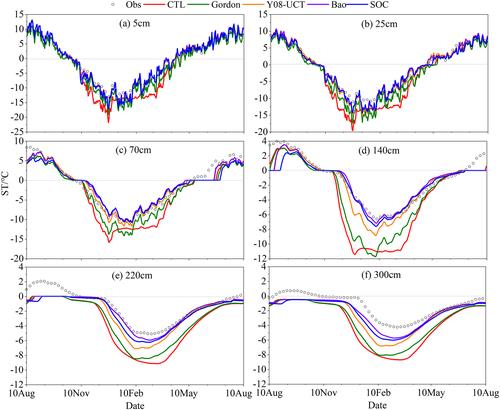Scientists Improve Land Surface Model for Simulating Hydrothermal dynamics of Active Layer on the Qinghai-Tibet Plateau
Updatetime:2020-09-21From:
【Enlarge】【Reduce】
The hydrothermal regime of the active layer in the permafrost regions on the Qinghai‐Tibet Plateau (QTP) is of great importance to the dynamics of underlying permafrost and climate in Asia.
However, a majority of the state‐of‐the‐art land surface models, which are effective tools for the study of permafrost changes and its interactions with the atmosphere, still have large bias in representing soil temperature and soil moisture.
Recently, scientists from the Northwest Institute of Eco-Environment and Resources (NIEER) of Chinese Academy of Sciences (CAS) assessed the Noah‐MP model for simulating soil hydrothermal dynamics at two typical permafrost sites with different underlying surfaces (the Tanggula site, alpine meadow; the Beiluhe site, alpine swamp) of the QTP. And several practical augmentations regarding snow sublimation, turbulent processes, soil thermal conductivity, and soil organic matter were integrated into the model.
They have established a set of numerical experiments, and found that Noah‐MP tended to underestimate soil temperature and moisture. The underestimated temperature resulted from overestimated snow depth was reduced by introducing the sublimation loss from wind. The remaining cold bias in the soil profiles was greatly resolved by a combined scheme of roughness length for heat (Z0h) and under-canopy aerodynamic resistance (ra,g).
Moreover, more realistic frozen soil thermal conductivity could further improve the deep soil temperature simulation. The consideration of soil organic matter could mitigate the underestimation of shallow soil moisture, but this improvement was more obvious at the Tanggula site with coarser mineral soil.
This study has implications for understanding the land surface process in the QTP, and the findings have been published in the Journal of Geophysical Research: Atmospheres in an article entitled “Improving the Noah-MP Model for Simulating Hydrothermal Regime of the Active Layer in the Permafrost Regions of the Qinghai-Tibet Plateau”.

Variations in the daily mean soil temperature (ST in °C) at (a) 5‐cm, (b) 25‐cm, (c) 70‐cm, (d) 140‐cm, (e) 220‐cm, and (f) 300‐cm soil depths at the TGL station from 10 August 2010 to 10 August 2011 for the observations, CTL, Gordon, Y08‐UCT, Bao, and SOM. (Image by WU Tonghua)
Contact:
WU Tonghua
E-mail: thuawu@lzb.ac.cn
Northwest Institute of Eco-Environment and Resources, Chinese Academy of Sciences, Lanzhou 730000, China.
Appendix




